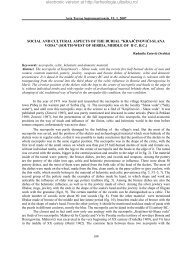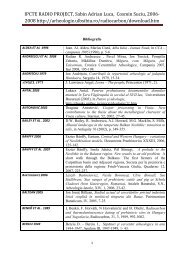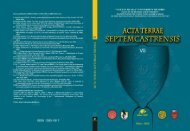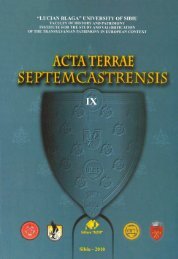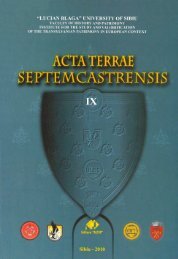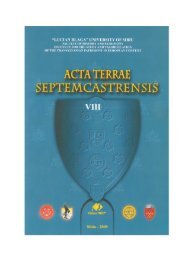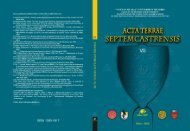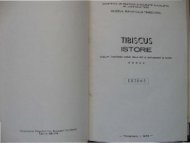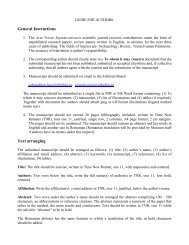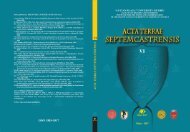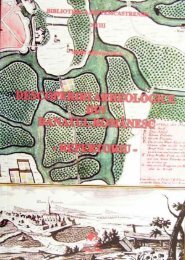acta terrae septemcastrensis viii - Institutul pentru cercetarea Åi ...
acta terrae septemcastrensis viii - Institutul pentru cercetarea Åi ...
acta terrae septemcastrensis viii - Institutul pentru cercetarea Åi ...
Create successful ePaper yourself
Turn your PDF publications into a flip-book with our unique Google optimized e-Paper software.
Acta Terrae Septemcastrensis, VIII, 2009<br />
The Blooming stage of the experiment with writing<br />
Throughout the Late Neolithic, far-reaching changes occurred in the social,<br />
cultural, and even ethnic makeup of Southeastern Europe with the emergence of<br />
new cultural complexes and groups. In the Vinča C, Turdaş, Gradešnica, and<br />
Karanovo IV and V horizon, literacy progressed and assumed the role of a key tool<br />
for social reproduction, reaching the greatest variety and richness.<br />
The Blooming stage of the Danube script was sustained at first by Vinča C<br />
settlements, which concentrated about one third of the signs belonging to this<br />
period. In addition, the pivotal role of Vinča C revolutionized the spreading model<br />
of the script settled during the previous stages with a resolute extension towards<br />
the south, substantially involving the Bulgarian and Greek territories. This trend is<br />
connected to the social, economic, and cultural upheaval that some scholars call<br />
“Vinča shock” due to successive migrations from the south with several<br />
intermediate stages (Lazarovici Gh. 1979: 118, 137, 1987, 1994; Kalmar 1991:<br />
124 ff.).<br />
The second gravitation center of writing was the Turdaş culture, with a<br />
22.8% concentration. It had its genesis on a Vinča B foundation implanted with<br />
Vinča C1 elements established in southwestern Transylvania and in the basin of<br />
the medium course of the river Mureş. DatDas provides evidence that the Turdaş<br />
settlement participated in a leading position in the development of the system of<br />
writing during its booming period.<br />
The input from the third pillar in the flowering of the system of writing was<br />
much more limited: the Karanovo IV–Kalojanovec culture in south-central<br />
Bulgaria (10.5%), which has exhibited correspondences in Precucuteni I from<br />
Moldavia and Eastern Transylvania (C.-M. Lazarovici and Gh. Lazarovici 2008).<br />
The fourth developing column was the Tisza–Herpály–Csöszhalom complex,<br />
settled principally in Hungary, but also in Romania (5.1%).<br />
The wide territorial distribution of the Danube script, the differentiation in<br />
function with occurrence also beyond the sacred sphere, and the growing<br />
capability to connect and distinguish communities through regional gravitations of<br />
writing are strong indicators of increasing complexity in the Southeastern Europe<br />
throughout the Late Neolithic.<br />
The Stamina stage of the script<br />
The Stamina stage (c. Early Copper Age) was a resistance period for the system of<br />
writing within an economic socio-cultural framework that reached a high degree of<br />
civilization equal to that one of the Eastern Mediterranean basin. However, the<br />
peripheral position and the beginning of attacks and intrusions from the less<br />
advanced neighboring populations from the eastern steppe led to a decrease in the<br />
rhythm of evolution (Luca 2006a: 45). If it was a declining phase, however it was<br />
still vital, with 18.8% of the totality of the signs.<br />
During the Stamina stage, the main gravitational center of the Danube script<br />
was the Bulgarian Gradešnica–Brenica, which settled in northwestern Bulgaria.<br />
This culture was characterized by extensive utilization of the script as well as<br />
41



